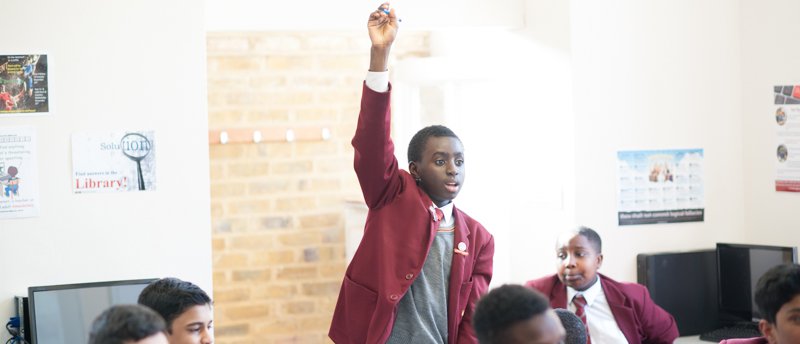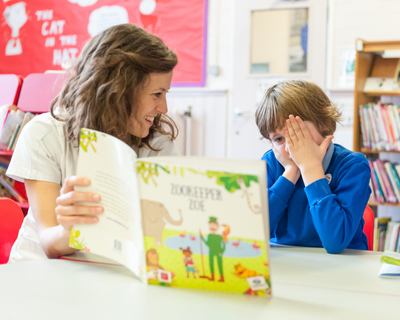COVID-19 and literacy: The attainment gap and learning loss

The attainment gap: a brief context
Pre-pandemic studies show that on entering primary school, the attainment of children from lower-income households is around 4.6 months behind those from higher-income households, increasing to around 9 months by the time they leave primary school.
The gap increases again at secondary school, with pupils from disadvantaged backgrounds leaving around 18 months behind their peers. Following some progress, efforts to narrow the attainment gap were stalling prior to the pandemic, and in 2019, the gap was found to have increased at primary level for the first time since 2007.
One factor identified in relation to the lack of progress made in narrowing the gap is a higher proportion of children in persistent poverty (Hutchinson et al., 2020).
‘Learning loss’ describes differences between levels of learning in pupils affected by educational disruption related to COVID-19 and what would be expected in a typical academic year. Research carried out over 2020 and 2021 has found some differences in learning loss in relation to socioeconomic background and region. For example:
- In autumn 2020, research carried out by the Department for Education (DfE), the Education Policy Institute and Renaissance Learning found a learning loss of up to 2 months in reading in both primary and secondary pupils, based on STAR assessments of more than 400,000 pupils (DfE, 2021).
- Secondary schools with a high proportion of pupils from disadvantaged backgrounds had learning losses 50% higher than those serving fewer pupils from disadvantaged backgrounds (2.2 months vs 1.5 months). This indicated that the principle, if not the extent, of the predicted widening of the attainment gap (see, e.g. EEF, 2020) was correct.
- In addition, after adjusting for historic differences in pupil progress, primary-aged pupils were found to have between 1.7 and 2 months’ mean learning loss in reading. However, pupils in the North East and Yorkshire and the Humber lost slightly more - 2.4 months and 2.2 months respectively (DfE, 2021).
- Similarly, secondary-aged pupils in the North East and Yorkshire and the Humber experienced the greatest learning loss (2.3 and 2.4 months respectively). Learning losses were smallest in the South East (1.2 months), the East of England and the North West (both 1.3 months).
- As might be expected, different outcomes emerged as further studies were carried out exploring different aspects of literacy, and using different assessment methods. For example, in October 2020, an assessment of 112,000 children’s writing skills by No More Marking suggested that new Year 7 students were 22 months behind where they should be (Christodolou, 2020), and that the gender gap (in favour of girls) had also increased, as had the gap between pupils eligible for pupil premium and their peers (albeit very slightly, from 13 to 15 points). However, as the study authors state, no historic data was available for comparison, making it difficult to tell to what extent this might be ‘typical’ or happened mainly as a result of the disruption caused by COVID-19.
- Findings reported by RS Assessment in November 2020 also indicated that the attainment gap between children from lower and higher income homes increased over the period of school closures (Blainey et al., 2020). Based on the standardised test scores of more than 250,000 primary school pupils, the study found ‘substantial drops’ in attainment between 2019 and 2020 across all subjects and year groups.
- Younger children, those eligible for the pupil premium and schools with higher levels of deprivation, in urban areas and in the North or the Midlands all showed greater declines. Indeed, the Midlands accounted for almost all declines in older age groups in 2020 tests.
- Later analysis of spring 2021 reading tests found that schools in the Midlands had the largest drops in Years 3, 4 and 5 (Blainey et al., 2021). Study authors suggested, however, that this could be linked to the fact that in their sample, schools in the Midlands had the highest overall FSM rates.
- In April 2021, headlines warned of a ‘lockdown illiteracy surge’ after (then) Education Recovery Commissioner Sir Kevan Collins suggested the number of primary school children struggling with literacy had increased by 30,000 to 200,000 over the previous year (based on currently unpublished government figures). The government is expected to publish a review and four-year plan to address this in late summer 2021.
- By contrast, in May 2021, research published by the Fisher Family Trust, Education Data Lab, Teacher Tapp and the EEF (Weidmann et al., 2021) found that the attainment gap widened only “slightly” between autumn 2019 and summer 2020, and that it also closed slightly between summer 2020 and autumn 2020, with changes effectively “cancelling each other out” (Allen et al., 2021). Report authors concluded that “we can’t be confident that the attainment gap in reading changed at all”. Interestingly, this research also found that none of the responses/ activities carried out by schools (such as live-streaming, phone calls, extra time) appeared to have any significant impact on pupils’ reading outcomes.
- A report published in July 2021 quantified learning loss in England since the beginning of the pandemic based on data from studies of commercial reading assessments (Newton, 2021). 10 studies were included, with most providing data from autumn term 2020 and relating to primary-aged pupils. The report noted that younger primary-aged pupils were further behind expectations than older ones. While some older primary school students were “actually ahead of expectations in reading” by late autumn 2020, this related to schools with lower than average percentages of pupils eligible for free school meals (FSMs).
- In October 2021, research published by the DfE, EPI and Renaissance Learning based on assessments in spring and summer terms 2021 indicated important differences in learning loss by key stage, individual and regional disadvantage for pupils in England.
- Nationally, in March 2021, the average learning loss in reading for primary-school aged pupils was 2.2 months. By June 2021, this had decreased to 0.9 months, indicating some level of recovery. However, there was less progress for secondary pupils. Losses of 1.5 months in autumn term 2020 had decreased only slightly, to 1.2 months, by summer term 2021.
- Pupils eligible for free school meals showed greater levels of learning loss than their peers from more financially advantaged backgrounds. Average learning loss in reading for primary school-aged pupils eligible for free school meals in March 2021 was 2.7 months. However, by summer term, this decreased to 1.2 months.
- At the same time, learning loss in reading for secondary-aged pupils eligible for free school meals actually increased over the academic year 2020-21. In autumn, reading losses for disadvantaged pupils were 1.9 months, but by summer 2021, this had increased to 2.4 months.
- However, disadvantaged pupils in deprived areas show the greatest levels of learning loss overall in summer term, at 1.2 months for reading in primary and 2.7 months for reading in secondary pupils (DfE, 2021).
An ongoing summary of findings from assessment reports is available from the EEF.
Summary
Figures on the pre-pandemic gap in attainment between children from lower and higher-income households are concerning. Despite commendable and hard-won progress to close the gap over the last decade, the gap doubles between entry and exit from primary school (from 4.6 months to 9 months) and does so again (from 9 to 18 months) between finishing primary and finishing secondary school. In recent years, progress in closing the gap has shown signs of stalling, with researchers identifying an increasing proportion of children in persistent poverty as a contributory factor.
The likelihood of school closures contributing to a widening of this gap is a key concern for educational researchers. To date, studies appear to show that the impact of the pandemic on pupils' learning has been greater for those from disadvantaged backgrounds, and further that pupils in urban areas and regions such as the North, North East, Yorkshire and the Humber, and the Midlands have suffered greater learning loss in reading than their peers elsewhere.
Find out more about our work in communities.
It is important that outcomes in reading and writing assessments continue to be monitored, however, to examine the extent to which such differences may increase, or indeed narrow, over time. It is also worth noting differences in assessment methods and analysis may lead to different conclusions. For example, one study suggested that the attainment gap in reading may not have changed significantly. We will continue to read new studies with interest, and offer our thanks to all those engaged in studies providing insights into the priorities for funding and interventions over the coming months and years.
Support our work
Help us ensure 230,000 children do not fall further behind. This is an urgent appeal to support Literacy Recovery of children and young people in our most disadvantaged communities.
